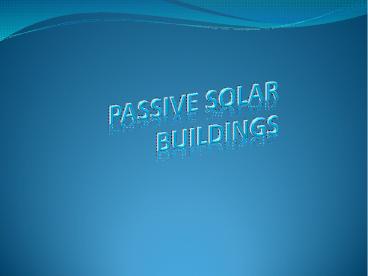PASSIVE SOLAR BUILDINGS - PowerPoint PPT Presentation
Title:
PASSIVE SOLAR BUILDINGS
Description:
Active solar technologies are employed to converts into solar energy another more useful form of energy. This would normally be a conversion to heat or electrical energy. – PowerPoint PPT presentation
Number of Views:2136
Avg rating:3.0/5.0
Title: PASSIVE SOLAR BUILDINGS
1
PASSIVE SOLAR BUILDINGS
2
INTRODUCTION
3
WHAT IS PASSIVE SOLAR BULIDING?
- A passive solar home means a comfortable home
that gets at least part of its heating, cooling,
and lighting energy from the sun.
4
HOW TO MAKE A PASSIVE SOLAR BUILDING
- It is designed to use the energy of sun. Its
material and building works together to create
energy. - THINGS WE NEEDED-
- Large windows
- Solid wall
- Water
- Fans
- Overhangs.
5
PASSIVE SOLAR BUILDING IDEAS
- APERTURE Large window expansion that allows sun
energy, it faced south, made improvements in more
low cost. - THERMAL MASS It is a construction material which
stores or collect energy from sun. - INSULATION Once power of the sun is collected,
it should not be waste. So, it eliminates the air
leak around the building. - DISTRIBUTION Helps to circulate the stored
solar energy when needed.
6
BENEFITS OF PASSIVE SOLAR BUILDING
- INVESTMENT Independent from future fuel cost,
save money long after initial cost recovery. - VALUE High owner satisfaction and resale value.
- MAINTENANCE Reduced operation and repair.
- COMFORT No operating noise, act as warmer and
cooler according to the climate(even in power
failure).
7
WHY PASSIVE SOLAR BULIDING NECESSARY?
- Passive solar design save energy by maximizing
the homes natural heating. - Passive solar building design very important role
in reducing the greenhouse emissions in our
society. - Creating passive solar building to save energy
which voluntary comply with openings are also
important compliments to passive heating
cooling.
8
DIFFERENCES FROM ORDINARY BUILDING PASSIVE
SOLAR BUILDING
- Passive solar building designThese standards are
much higher then houses built to most normal
building. - About 15 space heating in an ordinary home comes
from solar energy passive solar houses are
designed to let heat into the building during the
wintersimple huge difference in comfort - The building it self server as solar collector
storage device where as ordinary building not
like that.
9
FEATURES OF PASSIVE SOLAR BUILDING
- It uses the basic design to trap heat when
needed. - So, it keep the house cool in summer and hot in
winter. - It picks up lot of free heat in winter from
sunlight(contains about a kW of heat).
10
ACTIVE SOLAR
- Active solar technologies are employed to
converts into solar energy another more useful
form of energy. - This would normally be a conversion to heat or
electrical energy. - Active solar uses electrical or mechanical
equipment for this conversion. - Passive solar relies on the inherent
thermo-dynamic properties of the system or
materials to operate. - They do not need external energy source.
11
ENERGY-PLUS-HOUSE
- An energy-plus-house produces more energy from
renewable energy sources, over the course of a
year, than it imports from external sources. - This is achieved using a combination of micro
generation technology and low-energy building
techniques, such as passive solar building
design and careful site selection and placement. - A reduction of modern conveniences can also
contribute to energy savings, however many
energy-plus houses are almost indistinguishable
from a traditional home, preferring instead to
use highly energy-efficient appliances, fixtures,
etc., throughout the house
12
ZERO ENERGY BUILDING
- A zero-energy building(ZEB) or net energy (ZNE)
building general term applied a building with
zero net energy (ZNE) consumption and zero carbon
emission annually. - Reduce carbon emissions and reduce dependence on
fossil fuels - zero energy buildings remain uncommon even in
developed countries, they are gaining importance
and popularity.
13
DEVELOPMENT OF ZERO ENERGY BUILDING (ZEB)
- No ZEB regulations or standards
- Existing Energy Conservation Program
- Existing Green Building Label System
14
EFFICIENCY AND SOLAR ZEB
- First efficiency,
- then solar
- Together, they can
- make a big difference.
- Super-efficient solar
- Zero Energy Building.
15
WHY NET ZERO IS IMPORTEN
- Buildings are the Largest Energy Consumer in the
U.S. 40 of primary energy, 72 of electricity,
55 of natural gas.
16
WHAT ARE THE ADVANDAGES OF GOING ZERO ENERGY
- Money Savings (gt1,000s/year)
- Greater comfort.
- Better quality of life, more free time, more
money. - Less use, Less maintenance.
- Longer lasting heating and cooling equipment.
17
ADVANCING NET-ZERO ENERGY COMMERCIAL BUILDINGS
- In the United States, buildings account for
almost 40 of primary energy use and greenhouse
gas emissions. - Energy use will help address climate change and
extend the life of our national resources. - Has set a goal to achieve cost-effective,
net-zero energy commercial buildings in all U.S.
climate zones by 2020. - Renewable Energy Laboratory (NREL) leads the way
in net-zero energy building (NZEB) innovation.
18
SUMMARY
- Can achieve zero energy home now
- Design for efficiency and solar up-front.
- Super high level of energy efficiency.
- Encourage conservation of residents.
- Choose solar thermal for water and pool heating.
- Use small PV systems of 4kW or so (this is still
not cost effective at present electric rates
without subsidies). - Consider some PV on West side to reduce utility
peak. - Watch your meter spin backwards!!!!!
19
MY NET-ZERO ENERGY HOUSE(ALSO ZERO EMISSION
HOUSE)
- This house will save a projected 165,000 in fuel
and energy cost. - Over the next 20 years.
20
NEXT GENERATION ZERO ENERGY RESEARCH HOME
21
CONCLUSION
- We are saw about how to
- save energy.
- In this way we are follow
- to reduce usage of
- electricity.
- It will be help us and also
- our Future generation.































